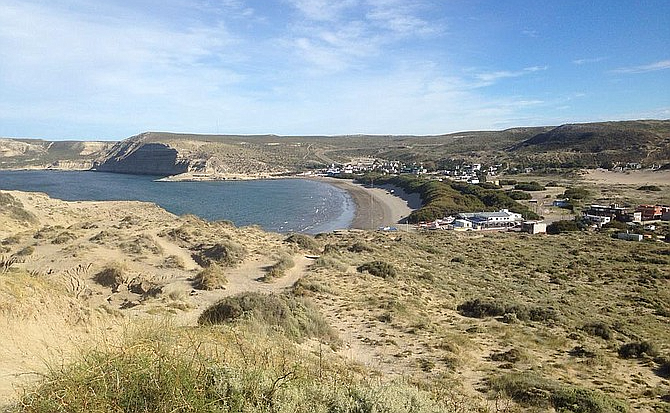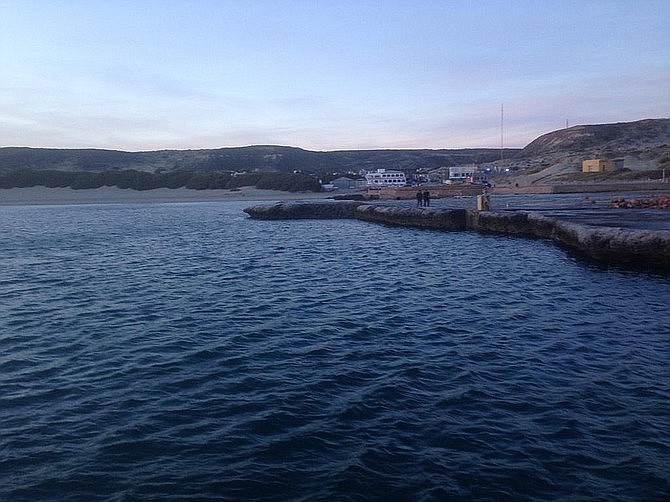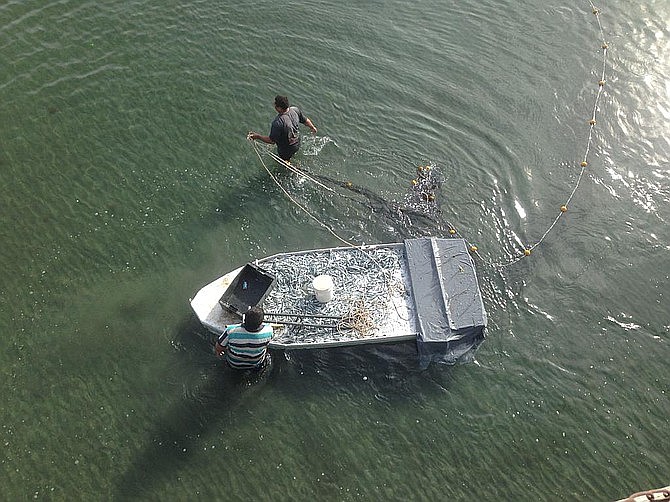 Facebook
Facebook
 X
X
 Instagram
Instagram
 TikTok
TikTok
 Youtube
Youtube

I first became aware of this enormous peninsula years ago when I heard about the burgeoning whale-watching attraction there. A thousand miles south of Buenos Aires on the south Atlantic coast, this region lies at about the same latitude as the north of Patagonia, 400 miles due west across the Argentine pampas.
The terrain at either end of this stretch couldn't be more different; the west is an emerald alpine wonderland, while the coast is flat, dry, scrub desert.

It took me eight years to finally make it, arriving in Trelew by plane and taking a 45-minute bus to Puerto Madryn. This appealing town is where a boat from Wales landed in 1865 after a two-month voyage that resulted in five deaths, two births, and one marriage. The settlers fanned out across the area, establishing themselves in villages named Trevelin, Gaiman, and Trelew.
Madryn sits on the massive Golfo Nuevo, a circular bay 60 kilometers across, with a somewhat smaller gulf, San Jose, just north of the isthmus where begins the fabled peninsula. This cape is among the largest on the continent, with the farthest points being over 170 km from the big port. These dimensions add to the isolation and splendid outback of the country, and villages and commercial developments are few and scattered. It's Baja California with a Galapagos slant.
This is the diving capitol of Argentina — water visibility is as good as it gets here, ranging from 20 to 50 feet, and there are heaps of different sites to visit. The whale watching season starts in June and runs through the end of the year, and this is when PM hits peak season.
Excursions and other boat viewings draw the droves, and there is a location half an hour north of town, El Doradillo, where the Southern right whales swim within scant meters from the shore. Similar to San Ignacio lagoon on the Pacific Baja side, this spot is best viewed at high tide, and the tides here are titanic, reaching 20 feet in a six-hour cycle. The extremes should have much to do with your recreational schedule.
A fine 5K stroll along the beach towards the south passes the site of the Welsh landing and historic monument above a worthy snorkeling venue.

A bit farther is the eco centro, a prominent building which was closed both times that I passed by but likely worth a visit. The municipal wharf extends half a mile out into the blue bay, and this is where the big ships – tourist, fishing, or other commercial types – tie up. Shore fishermen drag nets around in waist deep water, catching boatloads of small silver anchovies, and sizable light colored crabs are easily visible scurrying along the sandy bottom. There are plenty of sea lions here too, dozing and resting on the landings, and at least one energetic penguin chasing fish.
It's an easy place to spend a couple of days, but I was here to get to the peninsula, an hour bus ride away.
The park entrance is situated in the neck of the isthmus, and the $650 tariff (US $15) is beyond a bargain. The desert vegetation around Madryn resembles Arizona, with sage and creosote bush, but once out on the peninsula the creosote disappears, replaced by other varieties and grass but no cactus, no big boulders, and absolutely no trees.
The road drops into Puerto Piramides about 10 minutes past the gate, and this little village is about the only commercial neighborhood 50 kilometers in any direction. Dive shops, kayak and bike rentals, cafes and hotels make up most of it, along with a few ma and pa markets and a gas station. The lodging options number close to 40 in high season, but less than half that the rest of the year. There's also a municipal campground that charges $250 (US$6) per person which includes a shower.
The adjacent beach is lined by steep dunes and Tamarisk type trees and makes for a very chill setting. There is limited camping allowed elsewhere in the park on a free roaming basis, as the rangers want to keep the terrain as clean and pristine as possible. This village is the ideal base for exploring the many spectacles of this area, and three to five days is enough time to do it.
For myself and lots of others, the prime attraction is the arrival of pods of orcas – killer whales – who use certain stretches of beach here as hunting grounds for their meat and potatoes, the innumerable sea lions.
75k north east of Piramides lies Punta Norte, one of two locations in the world where the orcas will beach themselves in order to snag their prey. The rangers track, identify, and keep a close watch on these proceedings, and all observers are compelled to maintain their distance from a railed boardwalk fifty meters above the beach. The orcas don't show up on schedule, or even daily, and witnessed attacks are infrequent.
But witnesses show up every day hoping for a close look at the king of dolphins in the wild, and not captive in a big tank. It's difficult to put into words the exhilaration of seeing these animals up close, and I won't try, but in my case it made the hair stand up on my arms, like an electrical shock. The season runs from late in the year through April, and I hope to return next March.
The peninsula is an idyllic location to snorkel, kayak, SUP, mountain bike and hike, and the outdoor enthusiast will have plenty of choices. The locals say that only when the north wind blows is it inadvisable to be on the water, and outside of the winter months the odds of good weather are favorable. I took a couple of dandy hikes, one on a big wind day, and both were well worth the time and energy:
The first was a 5k scamper up a trail to a dirt road that leads to a massive loberia, a sea lion enclave below the actual pyramid shaped bluff that gave the village its name. There were two groups of guanacos en route, and a pair of ospreys riding the wind, and the road ends at a ranger station with bathroom overlooking the shelf where the lobos del mar congregate.
My second ramble was in the opposite direction south towards the next major point, Pardelas, some 15k distant. This is regarded as one of the finest diving and snorkeling venues in the park, with a sheltered location, crystal water and loads of fish. It can be reached entirely by beach if the low tide is timed right, but this entails good planning and a strident pace. Otherwise, a high route across the bluffs is in order for some of the trip, and this is ultra scenic and enjoyable as all hell.
When the water is flat, the Valdez is premium kayaking and stand up paddleboarding, it's the diving capitol of Argentina, and the snorkeling, fishing and wildlife watching are all at least 8 on a scale to 10. Right whale season lasts almost the entire orca offseason, and the sea lion population is jaw dropping. This is among the seemingly healthiest ecosystems is South America, and that's saying a lot. Distances are vast, traffic is scant, and a decent mountain bike and adequate energy offers a special wilderness opportunity unobtainable anywhere else. As long as that fierce north wind isn't blowing, peak outdoor experiences abound — and the Valdez merits a slot way up on The List.


I first became aware of this enormous peninsula years ago when I heard about the burgeoning whale-watching attraction there. A thousand miles south of Buenos Aires on the south Atlantic coast, this region lies at about the same latitude as the north of Patagonia, 400 miles due west across the Argentine pampas.
The terrain at either end of this stretch couldn't be more different; the west is an emerald alpine wonderland, while the coast is flat, dry, scrub desert.

It took me eight years to finally make it, arriving in Trelew by plane and taking a 45-minute bus to Puerto Madryn. This appealing town is where a boat from Wales landed in 1865 after a two-month voyage that resulted in five deaths, two births, and one marriage. The settlers fanned out across the area, establishing themselves in villages named Trevelin, Gaiman, and Trelew.
Madryn sits on the massive Golfo Nuevo, a circular bay 60 kilometers across, with a somewhat smaller gulf, San Jose, just north of the isthmus where begins the fabled peninsula. This cape is among the largest on the continent, with the farthest points being over 170 km from the big port. These dimensions add to the isolation and splendid outback of the country, and villages and commercial developments are few and scattered. It's Baja California with a Galapagos slant.
This is the diving capitol of Argentina — water visibility is as good as it gets here, ranging from 20 to 50 feet, and there are heaps of different sites to visit. The whale watching season starts in June and runs through the end of the year, and this is when PM hits peak season.
Excursions and other boat viewings draw the droves, and there is a location half an hour north of town, El Doradillo, where the Southern right whales swim within scant meters from the shore. Similar to San Ignacio lagoon on the Pacific Baja side, this spot is best viewed at high tide, and the tides here are titanic, reaching 20 feet in a six-hour cycle. The extremes should have much to do with your recreational schedule.
A fine 5K stroll along the beach towards the south passes the site of the Welsh landing and historic monument above a worthy snorkeling venue.

A bit farther is the eco centro, a prominent building which was closed both times that I passed by but likely worth a visit. The municipal wharf extends half a mile out into the blue bay, and this is where the big ships – tourist, fishing, or other commercial types – tie up. Shore fishermen drag nets around in waist deep water, catching boatloads of small silver anchovies, and sizable light colored crabs are easily visible scurrying along the sandy bottom. There are plenty of sea lions here too, dozing and resting on the landings, and at least one energetic penguin chasing fish.
It's an easy place to spend a couple of days, but I was here to get to the peninsula, an hour bus ride away.
The park entrance is situated in the neck of the isthmus, and the $650 tariff (US $15) is beyond a bargain. The desert vegetation around Madryn resembles Arizona, with sage and creosote bush, but once out on the peninsula the creosote disappears, replaced by other varieties and grass but no cactus, no big boulders, and absolutely no trees.
The road drops into Puerto Piramides about 10 minutes past the gate, and this little village is about the only commercial neighborhood 50 kilometers in any direction. Dive shops, kayak and bike rentals, cafes and hotels make up most of it, along with a few ma and pa markets and a gas station. The lodging options number close to 40 in high season, but less than half that the rest of the year. There's also a municipal campground that charges $250 (US$6) per person which includes a shower.
The adjacent beach is lined by steep dunes and Tamarisk type trees and makes for a very chill setting. There is limited camping allowed elsewhere in the park on a free roaming basis, as the rangers want to keep the terrain as clean and pristine as possible. This village is the ideal base for exploring the many spectacles of this area, and three to five days is enough time to do it.
For myself and lots of others, the prime attraction is the arrival of pods of orcas – killer whales – who use certain stretches of beach here as hunting grounds for their meat and potatoes, the innumerable sea lions.
75k north east of Piramides lies Punta Norte, one of two locations in the world where the orcas will beach themselves in order to snag their prey. The rangers track, identify, and keep a close watch on these proceedings, and all observers are compelled to maintain their distance from a railed boardwalk fifty meters above the beach. The orcas don't show up on schedule, or even daily, and witnessed attacks are infrequent.
But witnesses show up every day hoping for a close look at the king of dolphins in the wild, and not captive in a big tank. It's difficult to put into words the exhilaration of seeing these animals up close, and I won't try, but in my case it made the hair stand up on my arms, like an electrical shock. The season runs from late in the year through April, and I hope to return next March.
The peninsula is an idyllic location to snorkel, kayak, SUP, mountain bike and hike, and the outdoor enthusiast will have plenty of choices. The locals say that only when the north wind blows is it inadvisable to be on the water, and outside of the winter months the odds of good weather are favorable. I took a couple of dandy hikes, one on a big wind day, and both were well worth the time and energy:
The first was a 5k scamper up a trail to a dirt road that leads to a massive loberia, a sea lion enclave below the actual pyramid shaped bluff that gave the village its name. There were two groups of guanacos en route, and a pair of ospreys riding the wind, and the road ends at a ranger station with bathroom overlooking the shelf where the lobos del mar congregate.
My second ramble was in the opposite direction south towards the next major point, Pardelas, some 15k distant. This is regarded as one of the finest diving and snorkeling venues in the park, with a sheltered location, crystal water and loads of fish. It can be reached entirely by beach if the low tide is timed right, but this entails good planning and a strident pace. Otherwise, a high route across the bluffs is in order for some of the trip, and this is ultra scenic and enjoyable as all hell.
When the water is flat, the Valdez is premium kayaking and stand up paddleboarding, it's the diving capitol of Argentina, and the snorkeling, fishing and wildlife watching are all at least 8 on a scale to 10. Right whale season lasts almost the entire orca offseason, and the sea lion population is jaw dropping. This is among the seemingly healthiest ecosystems is South America, and that's saying a lot. Distances are vast, traffic is scant, and a decent mountain bike and adequate energy offers a special wilderness opportunity unobtainable anywhere else. As long as that fierce north wind isn't blowing, peak outdoor experiences abound — and the Valdez merits a slot way up on The List.
Comments